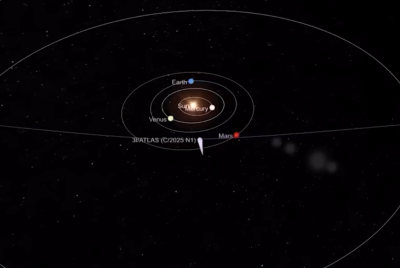3I/ATLAS Update: Interstellar Object Allegedly Poised To 'Trap' Earth With R2 Swan Comet - Anomalies Revealed
Amateur observers noted unusual alignment of 3I/ATLAS and comet C/2025 R2 (SWAN), calling it a 'cosmic trap'

Amateur astrophotographers and social media users have sparked discussion over unusual activity involving the interstellar object 3I/ATLAS and the newly discovered comet C/2025 R2 (SWAN). Some posts suggest the two objects appear aligned across the sky in a pattern described online as a 'cosmic trap'. These claims have captured public attention, though scientists emphasise that the apparent proximity is a visual coincidence and does not pose any danger to Earth.
Observers have noted that both 3I/ATLAS and R2 Swan displayed sunward-facing tails, green colouring, and apparent synchronous changes in brightness. A viral TikTok video by user @itsjeremyscottofficial described the objects as 'both glowing green, both acting weird, and right now they're sitting on opposite sides of Earth.' The post highlighted what seemed to be simultaneous brightening and tail formation, framing the alignment as unusual. Additional posts on X and astronomy forums have echoed these observations, sharing long-exposure photographs and amateur sketches.
Scientists caution that while these observations are visually striking, they do not indicate any threat. 3I/ATLAS and C/2025 R2 (SWAN) are separated by hundreds of millions of kilometres, moving on independent orbits. Any apparent alignment is a line-of-sight effect from Earth and does not reflect a physical interaction or celestial 'trap'. The viral speculation is therefore illustrative of how striking images can generate public interest, even when the underlying science is straightforward.
Confirmed Observations of 3I/ATLAS and R2 Swan
3I/ATLAS, the third known interstellar object to pass through the Solar System, was discovered on 1 July 2025 by the ATLAS survey. Its orbit is hyperbolic, confirming an origin outside the Solar System. Multiple observatories, including Hubble and JWST, have documented its coma, dust tail and gas emissions, confirming active comet-like behaviour.
Comet C/2025 R2 (SWAN) was discovered on 11 September 2025 via imagery from the SOHO–SWAN instrument. The comet was catalogued by the astronomical community and has since been observed by amateur and professional observers, with reports of a visible coma and tail under favourable sky conditions.
@itsjeremyscottofficial “Tell me this is normal.” Two different objects, same rare sunward-facing tail, same green glow, same weird behavior, and now sitting on opposite sides of Earth like a cosmic squeeze play. People keep saying “it’s just a rock,” but the timing, alignment, and sudden changes with R2 SWAN and 3I ATLAS are way too strange to ignore. Space is acting different right now, and the data is right in front of us. #3IAtlas #R2SWAN #SpaceUpdate #SkyWatchers #IntoTheUnknown
♬ The Dark Sorcerers Trial - Perfect, So Dystopian
💥 Shit is getting real now... Comet R2 SWAN Has Grown a Sunward Tail like 3I/ATLAS (!) as Both Now Strategically Surround Earth 👾https://t.co/7EJuaWcg8s#shoutout @StefanBurnsGeo#Boomshakalaka #R2Swan #3IATLAS #AgeOfDisclosure
— Jason Silvestri (@JasonSilvestri) November 26, 2025
At present, there is no published, peer-reviewed evidence confirming that 3I/ATLAS and C/2025 R2 (SWAN) have been imaged simultaneously in the same region of the sky. Likewise, long-period orbit estimates for SWAN remain uncertain, and claims of several-degree tail lengths or detailed comparative morphology are speculative. Some images and posts circulating on social media suggest that the two comets appear near each other from certain viewpoints on Earth, sometimes described as creating a 'trap' effect, but these remain unverified and are not supported by formal astronomical observations.
Understanding the Viral Claims
Social media posts describing the objects as forming a 'cosmic trap' have amplified public fascination, but scientists emphasise that these narratives are coincidences of perspective rather than extraordinary events. The episode illustrates the tension between viral astronomy content and scientific consensus: striking images can generate excitement but do not replace rigorous orbital calculations or peer-reviewed data.
For now, experts agree that both 3I/ATLAS and R2 Swan remain of scientific interest. They offer a rare opportunity to study an interstellar object alongside a long-period comet. Despite their apparent synchrony, the two objects pose no risk to Earth. The unusual images circulating online reflect observational perspectives and natural cometary behaviour rather than a cosmic threat.
© Copyright IBTimes 2025. All rights reserved.





















